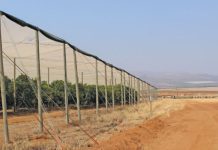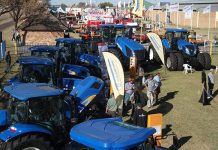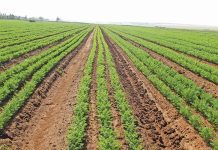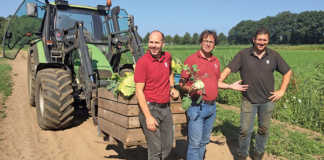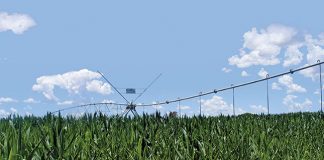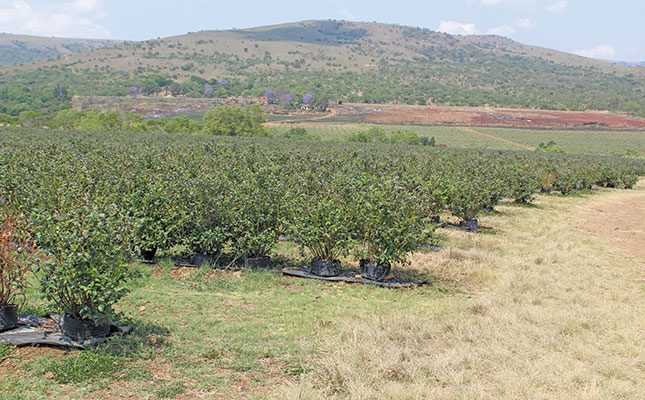
Photo: Lindi Botha
Blueberry production has skyrocketed in South Africa in recent years, thanks to new cultivars that can be grown in a variety of climates, as well as to increasing demand for superfoods.
In 2017, when Luan Swart, owner of Bluedrop Berries near Lydenburg, Mpumalanga, sought a high-value crop for his farm, blueberries were an attractive option.
“I wanted an export crop that would earn an income in dollars or euros. At that stage, blueberry prices were really high, up to R250/kg, and because of our unique microclimate, it was a good choice.”
Swart ended up planting 10ha to blueberries of various cultivars and 5ha to blackberries on his farm, Rietfontein.
Temperature is the most important climatic factor in blueberry production, with the optimal maximum temperature being 26°C to 28°C. In this respect, Rietfontein, which is in a valley, is ideal; winter temperatures dip to a minimum of 0°C, and summers don’t exceed 30°C. Swart therefore plants varieties requiring between 400 and 600 chill units.
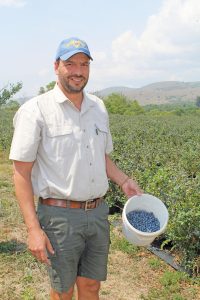
Another factor that contributes to the farm’s climatic conditions is temperature inversion, which helps the berries stay cool in summer. On cloudless days, heat rises quickly, keeping the valley floor cool.
“Our farm is small, but we have many microclimates because of the topography. We therefore have multiple sensors in each berry block to monitor the climate over time,” explains Swart.
“For optimal production, it’s important to choose the cultivars that best suit the climate. We’ve found that when we have a particularly cold winter, for example, some cultivars do better than others. In a warm winter, other cultivars perform better. In this way, we hedge against climate risks.”
Rain and irrigation
Berries require a fair volume of water, and Swart relies on irrigation to provide this, giving each plant about 4ℓ/day. The annual rainfall of 850mm is more valuable for replenishing the dams used for irrigation than for watering the plants directly, so it isn’t taken into account for irrigation planning. The rain is useful, however, for flushing the blueberry pots to remove salt build-up from fertiliser applications.
The region is notorious for hailstorms, but Swart has to date experienced few of these, and none has had a major impact on production.
Blueberries take two to three years after planting to bear fruit, and Swart therefore anticipated earning a good income from his crop by 2020.
“But then COVID-19 hit, disrupting markets, logistics and prices. No one could have foreseen a global pandemic that would have such a huge impact. At this point, I was very grateful we’d chosen the model we did for the farm and were able to stay afloat.”
Different production models
There are many models for blueberry production, each with its own opportunities, challenges and price tag. A high-input system, which can cost upwards of R2 million/ ha to establish, may entail greenhouse or netted structures and use ‘closed’ varieties, where royalties are paid per plant and per berry harvested.
Some models have commission structures in place at every step in the value chain, and usually require that only selected packaging material and packhouses be used.
“Many of the low-chill unit and newer varieties can only be accessed by entering into strict agreements with the licence holders,” explains Swart. “There are big commission structures in place, and as a farmer you have no say in where your berries are packed and at what price, and how many people are involved in the value chain, all collecting commission along the way.
“As soon as prices come under pressure, these models are no longer feasible because the price doesn’t support so many costs. You have to produce a berry that is so much better, but then the market isn’t prepared to pay that much for it.”
At the lower end of the scale, coming in at less than a quarter of the price per hectare to establish, are models where the berries are not restricted by licence agreements. They are planted in the open and farmers can pack and market them as they please. It is this model that Swart opted for and which has been his saving grace.
“Blueberries fetched very high prices when we started farming, so many farmers went for a high input-cost model. In theory, you should get higher yields and better quality when planting under structures, and many, not all, of the closed varieties do produce better berries. But you’d need consistently higher prices for your berries to pay back the
input costs, and I had a feeling the exceptionally high prices wouldn’t last. Today’s lower prices have affected us, too, but we can still make it work because we don’t have a big debt load.”
Swart advises farmers launching a blueberry enterprise to study data on cultivar growth and suitability to particular climates before selecting cultivars.
“Choose only those varieties that have proved to be successful in your area.
“It’s a big investment to make, only to sit without a harvest just when you thought you were going to start receiving an income.”
Hydroponics
Swart plants his blueberries in pots in a hydroponics system, as direct soil planting
is rarely successful for this crop. No soil preparation is needed and the land is merely levelled before the pots are put down. As a growth medium, he uses perlite, coco peat and peat moss in equal quantities.
Due to the rising cost of the growth mediums, and wanting a medium that was heavier to prevent the pots from falling over, he started experimenting with adding sand to the mixture. This, however, appeared to reduce nutrient uptake and yield, so he discontinued the practice.
Pest control
Swart applies a biological approach to pest control and this, combined with the farm’s isolation from other crops, has enabled him to keep chemical costs to just 20% of those seen on the average blueberry farm.
He applies a foliar spray to the plants that acts as an immune booster, thereby increasing their resistance to pests. By keeping the plants healthy, he ensures that they are less prone to attack from plant lice and thrips, two of the biggest pests in blueberry production. An outbreak of thrips, however, may require chemical treatment, as the damage threshold is high.
Healthy plants are also able to resist diseases such as rust. Reducing pesticide use
provides another important advantage: it helps to slow down the build-up of resistance to the chemicals.
“Once resistance has developed, you need to use ever-harsher chemicals with longer withdrawal periods, which delays transportation of the fruit to the market,” says Swart.
Yield and pricing
Swart’s blueberry yield averages 20t/ ha, in contrast to the 30t/ha achieved by growers who produce blueberries in tunnels.
“Every farmer needs to calculate and see what works best for him or her. With our system, we can’t sell our blueberries for under R45/ kg or we start losing money. For high-input systems, the price is around R65/ kg. Looking at prices obtained this year, it’s clear why so many growers are going out of business.
“It’s difficult to say which system is better; each has its pros and cons. But I know that if I’d gone for a high input-cost system, I’d no longer be here, even with higher yields.”
Swart’s on-farm packhouse was built with this philosophy in mind. Although it required a large initial investment, in the longer term it helped bring down packaging costs.
A volatile market
The berry market, like many others driven by exports, has periods during which profits are high due to low supply. Swart explains that Peru is by far South Africa’s biggest competitor in berries, and once that country’s crop starts reaching the European and UK markets around mid-November, prices drop.
“Peru’s volumes are four times that of ours and their government has been proactive in securing favourable trade agreements with markets abroad. The UK was always a good market for us and the shipping route was cheaper, but now that the Peruvians have negotiated better deals, the UK just isn’t interested in our berries anymore. South Africa is now looking at smaller markets elsewhere, but they’re less lucrative.”
Swart’s harvest starts in early September and ends around mid-December. He therefore has the opportunity to earn high prices for at least half of his crop on the export market. While he has always aimed to export at least 90% of his crop, logistical problems and high shipping costs have brought that figure down to 70% this year.
“The profitability of the export market has become dependent on external factors such as whether the ports are operating properly, the cost of airfreight, and market volumes. Sometimes, the price I receive on the local market is better because the costs and risks when exporting are too high. We had an incident last year, for example, where the airline didn’t keep the berries cool and they were all spoiled. The airline doesn’t take responsibility for that, so the loss was mine.”
Fortunately, the South African market for blueberries is picking up as consumers become more aware of the fruit.
“Four years ago, blueberries sent to the market would move bit by bit. But as volumes have risen, demand has been created and the market has become quite lively. Still, prices are sensitive to supply spikes.
“Earlier this year there were strikes at the ports, so blueberries were destined for the export market suddenly flooded the local market and prices plummeted. It was just a two-week disruption in trade, but once prices drop, they take a long time to pick up again. These seemingly small disruptions all add up to unprofitable seasons. And for growers with high-cost models, it can be the straw that breaks the camel’s back.”
Managing input costs
Swart says that where blueberries were once highly profitable, producing them is now only feasible if input costs are kept low.
“You can’t control fertiliser and labour costs, but there’s wiggle room with the other input costs. You need to find the balance between yield, production costs and blueberry prices. Some growth mediums are cheaper, but the yield reduces, while the opposite is true for others. I’ve done my calculations to see which option works best for me between what I put in and what I get out.
“Economies of scale also play a role in profitability, but here too you need to find the balance between fixed costs, such as a packhouse and tractors, and how many tons you have to produce to maximise return on investment. To get the most from my packhouse, for example, I need to increase my hectares under berries, but banks are [reluctant] to provide financing, which makes it difficult to grow and reach optimal economies of scale.”
Black swan events such as COVID-19 can quickly disrupt any balance sheet, no matter how promising the outlook for the particular commodity. With Swart’s conservative approach to his investment, he has managed to weather the storm and looks forward to a better future.
“I’m grateful I didn’t place myself under great financial strain when I invested in blueberries. And I’m still optimistic about the future. Input costs and market prices will level out,” he says.
Email Luan Swart at [email protected]. FW



